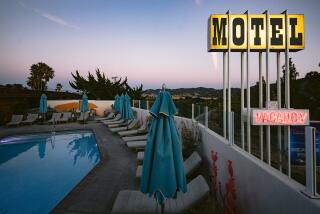‘The Village Beautiful’
- Share via
WILLIAMSTOWN, Mass. — Many people like to call this New England settlement “The Village Beautiful,” and it is. With its rolling, clipped lawns, its post card-white clapboard churches, its rows of venerable houses set back deeply from the street, it is surely one of the most fetchingly attractive settlements in the nation.
Tucked up in the northwest corner of the state a whistle from the Vermont border, it is the nest of Williams College, which gives it a patina not only of spirited youth but a certain special intellectuality.
Williamstown has only two real commercial streets, one busy, the other sleepy. But bulletin boards all over town are plastered with notices of theatrical presentations. And the sheer beauty of the village has attracted donors who have bequeathed magnificent museums, and other entrepreneurs who have come to open restaurants and, lately, a splendid inn.
The Orchards
Called the Orchards, the inn has opened with style on 3 1/2 acres that were once an apple orchard. Put together by Chester and Carole Soling, who were attracted to Williamstown’s beauty from their proper home in Scarsdale, N.Y., the inn has 49 rooms, some with wood-burning fireplaces, most with refrigerators and all with night lights, hidden TV, terry-cloth robes and English soaps.
Orchards will augment, albeit in cushy style, the venerable Williams Inn, which has long served as barracks for visiting alumni, parents and hopefuls seeking to enroll at Williams College. Its bar is still the weekend roisterers’ hangout, especially after the theater curtains ring down.
On the other scale, Orchards offers a hot tub and an environmental chamber where the supine participant can induce a selection of controlled elements from a spring rain to a warm breeze. A quartet of meeting rooms is for those who would settle social, business or governmental problems in this sequestered corner of the New England hills.
Williamstown has been called “Art Town, U.S.A.,” and not without reason. The masterpiece is the Sterling and Francine Clark Art Institute, which must rank with the great small museums of the planet. It owns 34 Renoirs. Works by John Singer Sargent, Winslow Homer and paintings and sculptures by Frederic Remington look out at you from every corner.
In between contemplating soft Gainsboroughs, assorted Lautrecs and even cases of silverware by Paul Revere, one can repair to the lovely umbrella-shaded cafe terrace under the great New England trees.
A Yale Man
Robert Sterling Clark never went to Williams. He was a Yale man who settled in Paris, secure as any heir connected with the Singer Sewing Machine fortune might be. He began collecting in 1912, highly influenced, especially in matters of Renoir, by his French wife.
The lure of Williamstown captured him. He started the institute with the huge classic extravaganza done in gleaming white Vermont marble. Next to it the exhibition halls were built. The Clarks occupied quarters in the original building until he died in 1956.
The Clark Art Institute will show “Monet in Massachusetts”--a collection of the artist’s works culled from statewide sources--through Oct. 6 and an Audubon show through the first week in September as well as its awesome permanent collection. Admission is free.
The Williams College Museum of Art, not quite as ambitious a show as the Clark, nonetheless can offer a Mary Cassatt, a Georgia O’Keefe and an Edward Hopper. One gallery holds the works of Maurice Prendergast and his brother Charles, who was a frame maker. Maurice has been termed the most avant-garde of what has been (unartfully) called the Ashcan School.
A stroll down Spring Street leads to Papa Charlie’s Deli Shop, festooned with straw Chianti bottles and salamis and cannonballs of provolone. The deli will serve a potato knish, Perry Como’s favorite chili and a baklava to finish you off. The bookstore next door features “Where the Girls Are Today,” subtitled, “The College Man’s Road Trip Guide to All Women’s Colleges.”
The Slippery Banana
If you slide into the Slippery Banana, what awaits you are loose pinto beans, green lentils or yellow peas, coffees from Kenya or Kona, croissants filled with spinach feta or ratatouille. Goodies, where the help is inclined to be more snappish than the name implies, has see-through walls filled with jellybeans in myriad colors and flavors, including one called coconut bubble gum.
The Potters Wheel, on Water Street, lays out a splendid collection of crafts by American artists working in stoneware, jewelry, hand-blown glass, woods and fibers. Worth a detour.
Williamstown Theater Festival goes through August, offering everything from Tennessee Williams to Noel Coward. A lively feature is the after-curtain cabaret held in assorted venues about town and featuring performers from the stage in special after-hours music.
The Cabaret plays at the Orchards on Thursday nights. If anyone waits around long enough, the breakfasts feature Williamstown specials, which could mean apple pancakes, pan-fried brook trout (called a Berkshire Mountaineer) and a plantation breakfast (sunny-side eggs, sausage patty, bacon and home fries).
After that it’s everybody for a jog to the Berkshire hills. In case of rain, the environmental chamber is programmed for suntans.
More to Read
Sign up for The Wild
We’ll help you find the best places to hike, bike and run, as well as the perfect silent spots for meditation and yoga.
You may occasionally receive promotional content from the Los Angeles Times.






